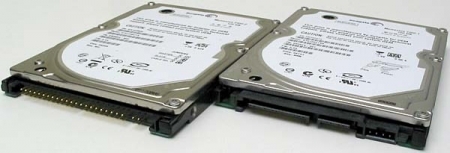
Things have picked up in Ask The Pros this month. It makes me think that many of us are upgrading our systems as opposed to passing them along and replacing. I know I’m using the same system I had two years ago and for me that’s a long time.
That brings us to a question from Mary. She’s beating all around the edges of a problem I ran into last year. All I wanted was to upgrade to a newer, faster laptop drive. As usual, it didn’t turn out to be that easy.
Q.Mary Asks: I want to replace my original laptop hard drive (Dell Inspiron 1200 – 30GB) with a larger one (160 or 250GB.) Several manufacturers (including Dell) claim 100% compatibility. But in comparing the specs, some differences are noted. Replacement hard drives are usually labeled ATA-2/3/4/5 but my hard drive is ATA-100. Is a 100 really compatible with a 2 or 3 or…? (YES) My drive’s rotational speed is 4200 rpm, replacements are 5400 rpm. Will increased speed also increase internal temperatures resulting in premature fan failure? (NO) Will existing drivers (obtained from the Dell support site and used during previous reformats / reinstalls) support a new hard drive even though these hard drives weren’t even in existence when my laptop was manufactured?(YES) Any other issues that might prevent a replacement hard drive from working? (SEE BELOW)
A. Great question Mary. There are some important points to consider in order to avoid the mistakes I made. First check to see which OS your laptop is using. If it’s XP, then your system must have a floppy drive or you must have an external floppy drive to provide the needed HD controller driver. It’s the hard drive controller that needs the driver. It doesn’t matter when the drives became available, as long as the controller is supported.
With XP finding the right driver can be a quest. You are correct in starting your search on the Dell site. Vista users will be able to provide the driver via CD, or thumb drive if necessary, and it’s more likely that Vista will contain the correct driver without you providing it. In either case, provide the driver at the F6 prompt during the installation.
Next consider whether you want to preserve the current installation with all of your programs and information. If the answer is yes then the simple solution might be to visit a service and repair shop. I’m not suggesting one at the larger chain stores, I’m suggesting a small local shop. The cost of a drive and the time required to replace and clone it should not be that much more than doing it yourself. Especially in the case of XP, this could save you some time and money. At the very least get a couple of quotes and compare it to the cost of buying the drive yourself. You might be surprised.
If your are going to clone the drive yourself, I suggest the free trial of Acronis True Image Home. If you have to purchase the software plus the drive, you will be looking at doubling your cost. You will need another system to do the job of cloning the old drive to the new drive and you’ll need the correct cables. You should be able to find a drive that fits your description from several of the online shops for between $59.00 to $69.00. That’s what I’m seeing today without doing much of a search. I’m sure there are better deals so do some searching to keep your costs low and reasonable for the system you are upgrading. Considering drive cost, cloning software, and a system and cables to clone the drives, the small local shop may be the better choice.
The ATA 2/3/4 designations you are seeing are basically a rating system that was never universally accepted and is rather outdated. It will have no importance to whether the drive you choose is compatible. As ATA advanced to bring better data transfer speeds, each new improvement was given a number to differentiate it from previous standards. More important to replacement is physical size, with 2.5″ standard for laptop hard drives.
Next to consider is connection type, and RPM. ATA laptop drives now impose a limit to not only your connection but to RPM as well. ATA laptop drives are limited to 4200 rpm and 5400 rpm, as you said. For a short time, there were 7200 rpm ATA laptop drives, but I haven’t seen one in over a year. If you can find one you may want to grab it.
Solid state or SSD drives are an option that others might consider. They are still expensive and not the best choice for large capacity needs, so I won’t go into those at this point. Just be aware that they can be lightening fast and easy to install, if you have SATA connections like those shown below. Open your laptop and take a look at the connection used for your drive. Confirm whether it’s ATA or SATA by using the pics below. ATA is on your left and SATA is on your right.

The rpms of the drive, 4200, 5400, 7200, will have the most impact on performance. If you have the more recent SATA connections be sure to go with a 7200 rpm drive. There are plenty available at very reasonable prices. Moving up to a 7200 rpm drive will remove the biggest bottle neck in your system.
Two years ago I had a big surprises when checking on the heat sources in my laptop.. I thought most of the heat was coming from the hard drive, but I was wrong. Most of the heat was coming from the area of the processor and memory, not the drive. Laptop drives run surprisingly cool. Changing to a faster, higher rpm drive will not significantly increase the heat and will significantly increase performance.
Good luck Mary. Get your drivers ready on a floppy, and thanks for asking.
SUBMIT A QUESTION HERE
Please note: we will not be able to respond to every question submitted. Selected questions will be answered in the Ask The Pros section of our Monthly Newsletter.




